|
Dear Friends and Neighbors,
Oregonians are doing a great job with mask compliance and social distancing, and our daily new cases have leveled off! But if we want to get our students back in classrooms we need to do even more. Today, the Governor and public health experts spoke about Oregon’s case data, what it means for school reopening and the future of our Coronavirus response. You can view her full press briefing here. She and OHA experts explain that while Oregon has once again flattened our curve, we have a lot of work left to get our daily cases, test positivity and infection rates down to a safe level for school reopening. There are two paths we can take to reach the metrics we need to reopen schools.
- We can increase our compliance with the current guidelines, that means more masks, more distancing, more compliance with OSHA guidelines, more contact tracing and testing, and more compliance with isolation for those who test positive. Most people are already complying with these rules, but we really need everyone to comply if we are going to reach our goals.
- We can tighten up restrictions further on individuals and businesses. This could mean any of the following (though none of these are imminent plans they are all on the table if cases stay at current levels):
- Travel Restrictions
- Mandatory quarantines upon entry
- Short term rental restrictions
- Hotel restrictions
- Restaurant and Bar Restrictions
- Outdoor seating only
- Restrictions on party size
- Other Business
- Closing gyms or fitness classes
- Closing event or entertainment venues
No one wants option 2 to be necessary, so we need even more help from individuals, communities, and businesses to increase our efforts with option 1. At the legislature, I will be working to get resources to communities so they can effectively test, trace and support those who need to isolate. But we also need everyone to do their part too. We all want to get students in classrooms as soon as possible, but our current case levels make that unsafe. Please do your part to get kids back in the classroom, and comply with all safety guidelines!
Daily New Cases:
As you can see from the table and graph below, our daily case counts have stabilized. This is great news! But we need to get the daily case number down from 300 per day to about 60 per day. And our number of cases per 100,000 down from 50 to 10.
 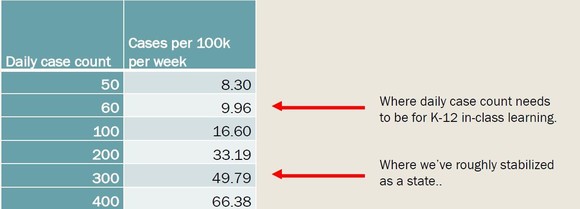 Test Positivity:
This number represents the percentage of COVID-19 tests that come back positive, and is important for both our understanding of the prevalence of the disease, and the sufficiency of our testing. Experts say that we need to have a positivity rate at least under 5% for school reopening to be done safely, and that under 3% would be even better. As you can see from the graph below our positivity rate has stabilized just above 5%. With increased testing and compliance we should be able to get this below 5%!
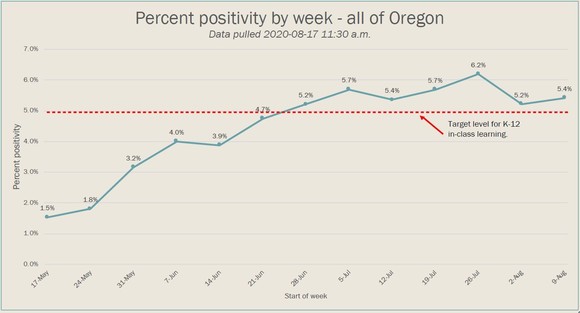 Infection or Reproduction Rate:
This is a metric you may not have heard as much about, but you will likely start to hear more. The infection rate of viruses is measured by a value called Rt or R0. The Rt is essentially the reproduction rate of a virus, or the number of people you might expect an infected person to pass the virus to. For example if the Rt is 1 then each person with the virus will spread it to 1 other person, if the Rt 2 then 1 infection will lead to 2 more, and so on. Currently our Rt is at about 0.95, which means that the virus is slowing down, but not enough to open schools in the fall. At this rate of transmission it will take till April to get to a daily case rate that is safe for school reopening. We need to get to an Rt of 0.75 in order to open schools this fall.
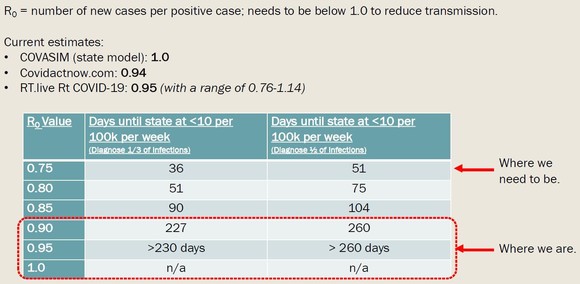
-
Don’t Delay Completing the Census! Make sure you get counted, and that Oregon gets its share of representation and funding! Fill out the census online: https://my2020census.gov/
-
Staying Healthy Through COVID-19: Many of us are struggling with mental health challenges, maintaining healthy habits, and managing working and studying at home. Tune into Straight Talk with Laurel Porter this weekend to hear from some medical experts about:
- How to stay physically and mentally healthy as we head into remote learning and extended working from home
- Keeping students active during online classes
- Setting up a work from home station that won’t cause physical strain
- Recognizing symptoms of depression and even grief as the pandemic continues
-
Vaping Work Group Releases Recommendations: This year, the Governor convened a work group of doctors and experts in pulmonology, pediatrics, and public health, as well as state legislators and state agency representatives to consider possible policy solutions to reduce youth vaping and vaping related illness. The work group released recommendations this week which you can read here.
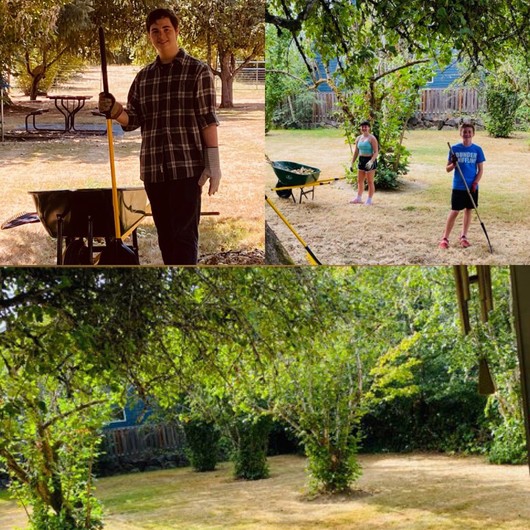 |
Today I had a great visit from my grandkids! They helped me rake apples in my yard. A great socially distanced (and helpful) vist!
-
National Numbers:
- Confirmed Cases: 5,551,793 (up 44,864 from yesterday)
- Deaths: 173,490 (up 1,074 from yesterday)
- These national numbers come from the Centers for Disease Control and Prevention. You can view their national and state by state data here.
-
Oregon Status Report: Oregon now has 24,421 total cases (confirmed and presumptive) of COVID-19.
- Today we have 259 new confirmed and presumptive cases, and 2 new deaths.
- Thursday: 301 cases, 4 deaths
- Wednesday: 203 cases, 11 deaths
- A total of 414 Oregonians have died from COVID-19.
-
Washington County still has one of the highest case counts at 3,447 cases, including 25 new cases today. You can review on-going updates from OHA by clicking on the table below.
- The Oregon Health Authority recently provided a Public Health Indicators Dashboard to enable communities across Oregon to monitor COVID-19 in the state.The dashboard, which will be updated weekly on Thursdays, provides a transparent report that presents complex epidemiological data in an interactive, easy-to-understand way on a state and county level.
 |
Table showing Oregon case, testing and demographic data, link to more information
Talking to Friends and Family about Masks:
Masks, face shields and face coverings are currently required statewide for offices and indoor public spaces, and outdoor public spaces when physical distancing is not possible. This has been an adjustment for all of us, but most are complying with the mandate to wear face masks and feel good about helping to reduce the spread of COVID-19. However, some people close to you may not agree with this requirement or may doubt the importance of wearing a mask. Here are some strategies for having conversations about face masks with friends and family, suggested by Oregon Health Authority:
- Ask them to help you understand where they’re coming from. “No one really wants to wear a mask, but I can tell this really bothers you. Is there anything I can do to help?”
- Avoid shaming or scare tactics, such as sharing stories of outbreaks due to non-masking or criticizing people who don’t mask. This type of talk is more likely to shut down conversations and make people who don’t mask more inclined to hide their behaviors.
- Share the facts. Oregon’s mask guidance website has facts about the effectiveness of masking to control the spread of COVID-19, the current state requirements for masking, and social media to share to bust common myths about face masks.
- Don’t forget that some people with disabilities have difficulty wearing face coverings. You don’t need to intervene if you see someone without a face covering.
What to do if you test positive for COVID-19.
If you have a confirmed positive COVID-19 test, you need to self-isolate for at least 10 days, even if you don’t have symptoms. This means:
- Staying away from everyone, including the people you live with and family members.
- Not sharing utensils or bathrooms with others.
- Only leaving home to seek medical treatment.
If you have a fever, you additionally need to self-isolate for at least 24 hours after your fever is gone (without the use of fever-reducing medication) and your symptoms improve.
If you feel better and have no symptoms at the end of your self-isolation period, you can resume normal activities. If you still feel sick, call your doctor for next steps.
To learn more, read OHA’s tips about how to self-isolate. This graphic also explains more about what to expect if you test positive for COVID-19.
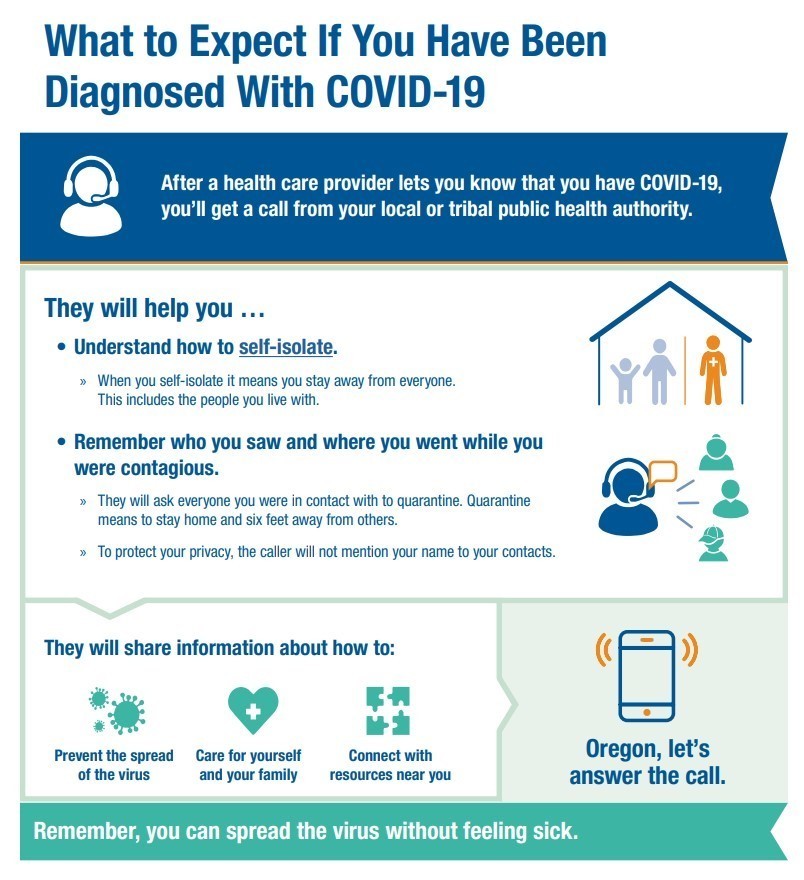 COVID-19 Health Equity Grants
The Oregon Health Authority (OHA) has opened grant applications to not-for-profit organizations statewide and Oregon’s nine federally recognized Tribes and the Urban Indian Health Program for grants flowing from legislatively-directed $45 million in federal CARES Act coronavirus relief funds.
The grants are intended to address the disproportionate impact the COVID-19 pandemic has had on Oregon’s tribal communities and communities of color. This innovative program leverages federal funds to address social determinants of health and the systemic racism and other health and economic inequities tribal communities and communities of color experience, which have been compounded by COVID-19.
The program will provide grants to not for-profit-organizations and tribal communities. These grants can be used to help people address:
- Health and economic disruptions. Examples of this could include: Providing thermometers, personal protective items, wage relief, childcare support, business consulting, and technology needs, to improve access to telehealth and distance learning.
- Food insecurity and housing. Examples of this could include: Providing food, shelter, transportation, home heating and cooling costs, and outdoor gear for situations of homelessness.
- Safety and violence prevention Examples could include: Providing emergency motel vouchers for people experiencing child abuse or domestic violence, culturally and linguistically appropriate services that address domestic violence, and social life skills programs for parents to address stress, depression and the need to take care of their own well-being.
Interested Tribes and organizations are invited to learn more about the grant program at their information session on Monday, Aug. 24 from 2:00 pm-3:00 pm. More information and an application are available here.
$500 Payment Program Concludes:
As you probably know, this week included the start and end of the Emergency Board’s Emergency Relief Payment Program. I am so pleased that we were able to distribute $35 million dollars to 70,000 struggling Oregonians in 3 days, but I know that there were many left waiting without relief at the end. Funds have been obligated to remaining appointments through Monday, August 31, so if you have an appointment, don’t cancel, as you should still receive funds. This program has put a spotlight on the level of desperation Oregonians and Americans are facing due to an inadequate federal response to this public health and economic crisis. Hopefully the federal government will step up to provide another round of direct stimulus to help struggling Americans, because the need is very clear. Thank you to all the Credit Unions and Banks that participated, and to all the Oregonians who waited for hours to receive these same day payments. You can read more about the program in this Oregonian Article. If you did not receive a payment or if you are still struggling despite it, you can call 211 or visit 211.org to find other forms of assistance, including food, rent and utilities.
Updates from the Employment Department:
Yesterday, Acting Director David Gerstenfeld shared some information with legislators about the employment outlook in Oregon and progress his department has made, check out the highlights below:
- Our monthly jobs report came out this week, showing one clear theme – Oregon’s economic recovery is going to be slow. Unemployment rate went down from 11.6% in June to 10.4% in July. Still more than 3x what it was in March.
- OED has paid out an astounding $3.9 billion since the start of this pandemic, and we have received more than 680,000 claims for benefits (Unemployment Insurance, PUA, and other programs; includes many duplicates).
- OED continues staffing up and have now gone from 100 employees processing claims prior to the pandemic to over 1,100. A 1,000% increase. Important since our unemployment system was set up such that each claim requires individual review. We have been asked if we are better prepared now, than in early March, to deal with another uptick of claims – the answer is yes, although our systems are still incredibly strained.
- There are still too many claims that have issues on them and have not been paid, or not been fully paid – the issues vary widely. For regular unemployment claims, the biggest issue is adjudication. For PUA, the largest issue is determining if the reason they are not working is due to a qualifying COVID-19 impact reason. We are adding capacity to comb through the claims in adjudication including people to gather needed information from claimants before the claim is assigned to an adjudicator. This should save time.
- OED is still experiencing some PIN reset issues and are working to address these.
- OED continues working to advance our project to modernize the unemployment insurance systems. They are building a talented team of leaders, project managers, and experts and will continue reporting out on our progress over the coming weeks and months.
You can watch or listen to Director Gerstenfeld’s complete briefing using these links:
You can visit the Employment Department YouTube Channel to view Webinars and helpful aids for filling out new forms.
You can use the Contact Us Form if you have any of the following issues:
- PIN reset
- Restart
- Weekly payment or missing payment (They are missing a week or a few weeks of benefits)
- Extended benefits - PEUC or EB
- Error on my claim
- Report Identify Theft
- Hasn’t filed, or not sure if they should file or not.
Ready Schools, Safe Learners-School District Plans
Hillsboro School District
Forest Grove School District
City of Hillsboro:
- Utility Assistance: City of Hillsboro residential customers impacted by COVID-19 may qualify to receive federal CARES Act utility assistance. This funding covers unpaid balances for water, sewer, and surface water management charges. Details here.
- Public Safety: Hillsboro City Council reviewed the public comments they received about Public Safety reform, and has decided to move forward on some important changes. You can read more here.
- Explore options of an independent Police oversight structure that would evaluate complaints, use-of-force incidents, and general policing policies.
- Expand equity training for the City Council and City staff, including the Police Department
- Continue working with the Hillsboro School District on the future of School Resource Officers.
- Research programs nationwide through a racial equity lens, including CAHOOTS based in Eugene, and propose a program that will help support the needs of community members experiencing mental health and/or homelessness challenges.
- Continue to engage community members, including partnering with community groups, to hear from more residents.
- Provide ongoing communication to residents on policy decisions and opportunities to provide input and give feedback.
City of Forest Grove:
New Pedestrian Plaza! The City of Forest Grove and the Forest Grove and Cornelius Chamber of Commerce have developed a Pedestrian Plaza plan to support small businesses. This will provide small businesses with more opportunities for outside seating, and foot traffic, as well as safety improvements for pedestrians making use of the expanded space.
I also had a great visit from my daughter and son-in-law this week! Thanks for the socially distanced visit Emily and Tom!
Employers and Employees
Education Links
Local Government
Utilities Assistance
Food and Housing Assistance
View Past Updates, Share and Subscribe:
If there was COVID-related information in a past newsletter that you want to go back to, but find you’ve deleted it, you can always go to my legislative website (http://www.oregonlegislature.gov/mclain), click on “News and Information,” and you’ll find them all there. You can also share this site with your friends and loved ones, so they can view past newsletters, and subscribe to future updates.
Yours truly,
 Representative Susan McLain
House District 29
email: Rep.SusanMcLain@oregonlegislature.gov I phone: 503-986-1429
address: 900 Court St NE, H-376, Salem, OR 97301
website: http://www.oregonlegislature.gov/mclain
|